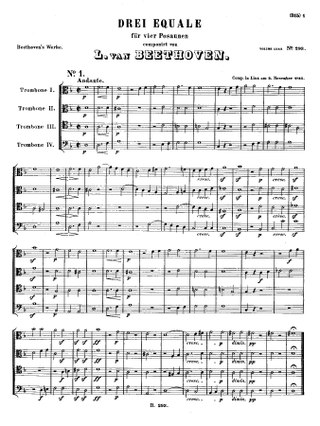Top Qs
Timeline
Chat
Perspective
Equale
Composition for equal voices From Wikipedia, the free encyclopedia
Remove ads
An equale or aequale (from Latin: voces aequales, equal voices or parts) is a musical idiom. It is a piece for equal voices or instruments.[1][2] In the 18th century the equale became established as a generic term for short, chordal pieces for trombone choirs, usually quartets or trios. The instruments were not necessarily equal in pitch, but formed a closed consort.[3]

Remove ads
Commemoration of the dead


Aequales were conventionally used in Austria to commemorate the dead. They were performed from towers on All Souls' Day (2 November), and on the previous evening.[4] They were also performed at funerals.[3]
While aequales might be played by other instruments, the sound of trombones was thought to be especially solemn and noble. Trombones had also already acquired an association with death and the afterlife.[3] Finally, the theological symbolism of the trombone, representing divine presence, the voice of the angels, and the instrument of judgment, was thereby underscored.[4]
Remove ads
Examples
Summarize
Perspective
Notable examples of the genre are the three Equali for four trombones of Ludwig van Beethoven (Drei Equale, WoO 30), written for Franz Xaver Glöggl and performed in Linz Cathedral on All Souls' Day (2 November), 1812. Two of them were later performed, with the addition by Ignaz von Seyfried of words from the Miserere, at Beethoven's own funeral in 1827. They were also played as instrumental pieces at the funeral of William Gladstone in Westminster Abbey in 1898.[5]
The two Aequali in C minor of Anton Bruckner date from 1847 and are for three trombones. Three years earlier, in 1844, the little-known Wenzel Lambel (1788–1861) of Linz had published ten equali for three or four trombones.[6] Stravinsky scored In memoriam Dylan Thomas, his setting of "Do not go gentle into that good night", for tenor, string quartet and four trombones, which may be an "echo" of the tradition.[5]
There is a passage of Aequale music in the coda of the finale of the sixth ("tragic") symphony of Gustav Mahler, given in counterpoint to four trombones and bass tuba (bars 790–816). Clarinets, bassoons and French horns provide a partial chordal accompaniment. This passage leads directly into the closing bars of the symphony.[citation needed]
Remove ads
References
Wikiwand - on
Seamless Wikipedia browsing. On steroids.
Remove ads
